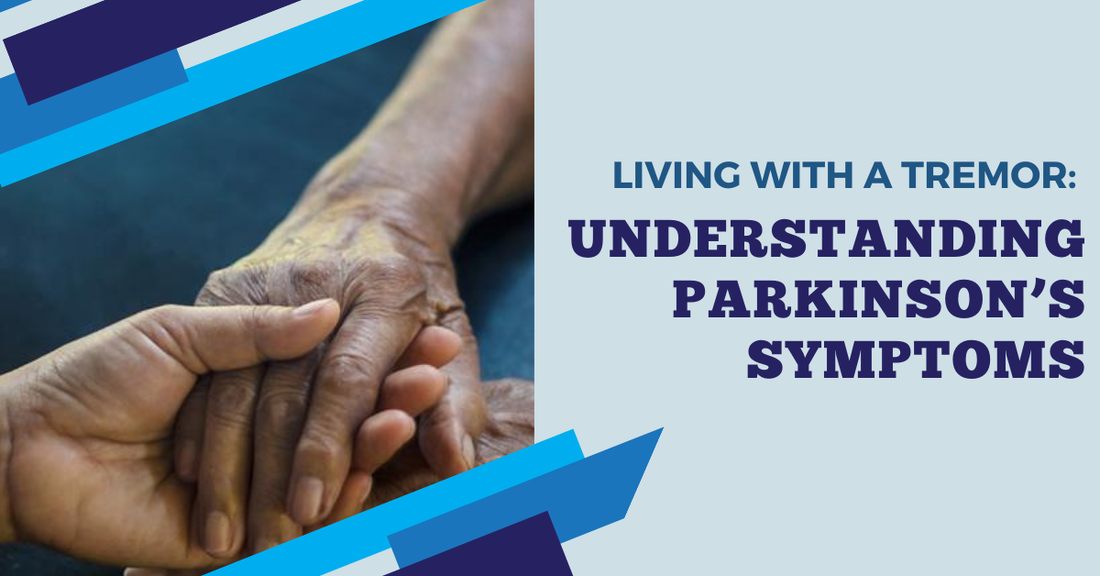
Living With A Tremor: Understanding Parkinson’s Symptoms
Share
Parkinson's disease can disrupt the normalcy of life, leaving many wondering what's happening to their bodies. Tremors, stiffness, and slowness are just a few of the telltale signs, but what exactly are these Parkinson's symptoms and how do they manifest? In this blog post, we'll delve deeper into the various symptoms of Parkinson's disease, helping you understand this condition and navigate the path forward.
Table of Contents
- Overview
- Few Early Signs of Parkinson's Disease
- Symptoms of Parkinson’s Disease
- Parkinson’s Disease Test? Is There One?
- Parkinson’s Disease Diagnosis and Treatment: Managing Symptoms and Improving Quality of Life
- Supportive Therapies:
- Dietary Adjustments:
- Medication:
- Surgery:
- Treating Additional Symptoms:
- Clinical Trials:
- Takeaway: Recognizing and Managing Parkinson's Symptoms
- Frequently Asked Questions
Overview
Parkinson's disease is a brain disorder that disrupts movement. It primarily affects nerve cells in a part of the brain called the substantia nigra, which produce dopamine, a vital chemical for movement control. As dopamine production decreases, movement issues arise.
The cause of Parkinson's disease remains unknown, but researchers suspect a combination of genetic and environmental factors may be at play. While genetics can make someone more susceptible, it doesn't guarantee developing the disease. Environmental factors like exposure to certain toxins or head injuries are also being investigated.
To know more about Parkinson’s Disease, click here.
Parkinson's symptoms typically start gradually and worsen over time. While there's no cure, treatment options can help manage symptoms and improve quality of life.
Few Early Signs of Parkinson's Disease
Parkinson's disease symptoms creep in slowly, often beginning with a subtle tremor in one hand and a general feeling of stiffness. As the disease progresses, additional symptoms emerge, and dementia can affect some patients.
Here's a breakdown of some early warning signs to watch out for:
- Movement changes: Tremors are common, but so are problems with coordination and balance, which can lead to falls and dropped objects.
- Reduced sense of smell: This can be a surprisingly early indicator of Parkinson's.
- Gait alterations: A slight forward lean or shuffling steps while walking might be a sign.
- Facial masking: Facial expressions become fixed due to nerve changes.
- Speech changes: A tremor in the voice or a softer speaking volume can occur.
- Micrographia: Handwriting becomes cramped and smaller.
- Sleep disruption: Restless legs syndrome and other sleep issues can be a sign.
Beyond the initial movement-related symptoms, Parkinson's disease can manifest in various other ways. Here's a look at some additional common issues:
- Mood shifts: Depression is a frequent companion to Parkinson's disease.
- Swallowing and chewing challenges: Difficulty with these functions can arise as the disease progresses.
- Fatigue: Many people with Parkinson's experience excessive tiredness, especially later in the day.
- Constipation: Digestive issues like constipation are also common.
- Skin problems: Skin may become oily or develop flaky patches.
- Cognitive decline: Dementia, delusions, and hallucinations can develop in later stages of Parkinson's disease.
It's important to remember that everyone experiences Parkinson's differently and having these symptoms doesn’t necessarily mean you have Parkinson’s disease. The severity and combination of symptoms can vary greatly from person to person. If you're noticing any of these issues, it's crucial to consult a doctor to discuss potential causes and appropriate management strategies.

Symptoms of Parkinson’s Disease
Parkinson's disease is a movement disorder characterized by a gradual onset of symptoms that often start mild. The specific symptoms and their severity vary significantly from person to person. It's unlikely someone with Parkinson's would experience all of these, and the order of appearance can differ as well.
Core Parkinson's Symptoms:
These core symptoms are often referred to as parkinsonism and directly affect movement:
- Tremor: A shaking, typically starting in the hand or arm, that's most noticeable when the limb is at rest.
- Slowness of movement (bradykinesia): Physical movements become much slower than normal, making daily tasks difficult and leading to a characteristic slow, shuffling walk with small steps.
- Muscle stiffness (rigidity): Stiffness and tension in the muscles, hindering movement and facial expressions, and potentially causing painful muscle cramps (dystonia).
Beyond Movement: Other Parkinson's Symptoms
Parkinson's disease can manifest in various ways beyond the core movement-related symptoms. Here's a look at some other common issues:
- Balance problems: These can increase the risk of falls and injuries.
- Loss of sense of smell (anosmia): This can sometimes appear years before other Parkinson's symptoms.
- Nerve pain: Causing unpleasant sensations like burning, coldness, or numbness.
- Urinary issues: Such as frequent urination at night or involuntary urination (urinary incontinence).
- Digestive problems: include constipation and swallowing difficulties (dysphagia), which can lead to dehydration and malnutrition.
- Sexual dysfunction: erectile dysfunction in men and difficulty achieving orgasm in women.
- Autonomic issues: like dizziness, blurred vision, or fainting upon standing due to sudden blood pressure drops, excessive sweating (hyperhidrosis), and drooling.
- Sleep problems: Including insomnia leading to daytime sleepiness.
- Cognitive and psychiatric symptoms: Depression, anxiety, mild cognitive impairment affecting memory and planning, and dementia with severe memory problems, personality changes, hallucinations, and delusions.
Remember, Parkinson's symptoms vary greatly. If you're experiencing any of these, consult a doctor for a proper diagnosis and discuss potential management strategies.

Parkinson’s Disease Test? Is There One?
Since there isn't a single definitive test for Parkinson's disease, diagnosis relies on a doctor's evaluation of your Parkinson's symptoms, medical history, and a thorough physical exam.
Your doctor will discuss the issues you're experiencing and may ask you to perform some simple physical or mental tasks, like walking or moving around, to assess your symptoms further. Early on, a diagnosis can be challenging because Parkinson's symptoms often start mild, making it difficult for your healthcare provider to definitively say whether you have the condition. However, a detailed evaluation can help identify patterns and rule out other possibilities.
Parkinson’s Disease Diagnosis and Treatment: Managing Symptoms and Improving Quality of Life
There's currently no cure for Parkinson's disease, but fortunately, there are treatment options available to help manage Parkinson's symptoms and maintain a good quality of life. Let's explore these options:
-
Supportive Therapies:
These therapies can significantly ease daily living with Parkinson's by addressing specific Parkinson's symptoms. They include:
- Physiotherapy: Improves stiffness, joint pain, and walking through targeted exercises.
- Occupational Therapy: Identifies challenges in daily activities (dressing, shopping) and helps develop practical solutions to maintain independence.
- Speech and Language Therapy: Addresses swallowing difficulties (dysphagia) and speech problems through exercises or assistive technology.
-
Dietary Adjustments:
Dietary changes can sometimes alleviate certain Parkinson's symptoms:
- Increase fibre and fluids: Reduces constipation, a common issue.
- Moderate salt intake and frequent small meals: Helps manage low blood pressure and dizziness.
- Dietary modifications: May address unintentional weight loss.
Related: Weight Loss Mudras
A dietician can create a personalized plan based on your specific needs.
-
Medication:
Medications are used to target the main Parkinson's symptoms like tremors and movement problems. Here's an overview of the common types:
- Levodopa: The most common medication, it increases dopamine levels in the brain to improve movement. However, long-term use can lead to side effects like dyskinesias and "on-off" effects.
- Dopamine Agonists: Mimic dopamine's effects in the brain, offer milder effects compared to levodopa. They can be helpful in the early stages or alongside levodopa. Potential side effects include nausea, sleepiness, and hallucinations.
Non-oral therapies may be considered when symptoms become difficult to control with medications. These include:
- Apomorphine: A dopamine agonist administered via injection, either as a single dose or a continuous infusion.
- Co-carbidopa and Foslevodopa-foscarbidopa: Continuously delivered medications into the stomach through a tube for severe Parkinson's with uncontrollable fluctuations.
-
Surgery:
Deep brain stimulation (DBS) is a surgical option for some people with advanced Parkinson's. DBS involves implanting electrodes in specific areas of the brain that regulate movement. These electrodes deliver tiny electrical currents to stimulate these areas, potentially alleviating symptoms.
Treating Additional Symptoms:
Parkinson's can manifest in various ways beyond movement issues. Here's a brief look at how some additional symptoms are managed:
- Depression and anxiety: Self-care measures like meditation, therapy, or medication can be helpful.
- Sleep problems: Adjusting bedtime routines can improve sleep quality.
- Erectile dysfunction: Medication can address this issue.
- Excessive sweating: Prescription antiperspirants or surgery in severe cases can provide relief.
- Swallowing difficulties: Modified diets or feeding tubes may be necessary.
- Drooling: Swallowing exercises, medication, or surgery can help manage this symptom.
- Urinary incontinence: Pelvic floor muscle exercises, medication, or surgery can offer relief.
- Dementia: Cognitive therapies and medication might be helpful in some cases.
Clinical Trials:
Clinical trials play a crucial role in advancing Parkinson's treatment by comparing new therapies and combinations with existing ones. Participation in these trials is voluntary and carefully monitored to ensure safety.
Remember, Parkinson's symptoms vary greatly from person to person. Discussing your specific needs and concerns with your doctor will help determine the most appropriate treatment plan for managing your Parkinson's disease and improving your quality of life.

Takeaway: Recognizing and Managing Parkinson's Symptoms
Parkinson's disease can present a range of symptoms, and the experience varies greatly from person to person. While there's no cure, many treatment options can help manage these symptoms and improve quality of life.
This blog provided a foundation for understanding common Parkinson's symptoms, including movement-related issues like tremors and stiffness, but also explored other potential signs such as sleep problems, mood changes, and cognitive decline.
If you're experiencing any of these Parkinson's symptoms, remember you're not alone. Early diagnosis and a personalized treatment plan are crucial. Talk to your doctor to discuss your concerns and get the support you need.
Frequently Asked Questions
Q.1 What is the main reason for Parkinson’s?
The cause of Parkinson’s remains unknown. However, doctors believe that environmental factors, genetics, accelerated ageing and loss of neurons are seen as potential causes.
Q.2 What age do people get Parkinson’s?
According to studies, most people with Parkinson’s first develop the disease after the age of 60.
Q.3 Can Parkinson’s be cured?
No, there’s no definitive treatment for the disease, however early medical intervention and regular therapies can help in managing it better.
Q.4 Is Parkinson’s Disease communicable?
It is not contagious or fatal. Parkinson’s disease is a degenerative neurological condition that affects the body's movements.
